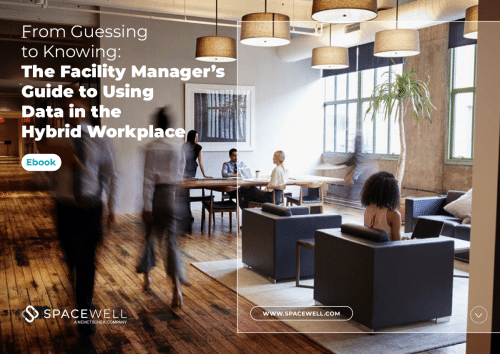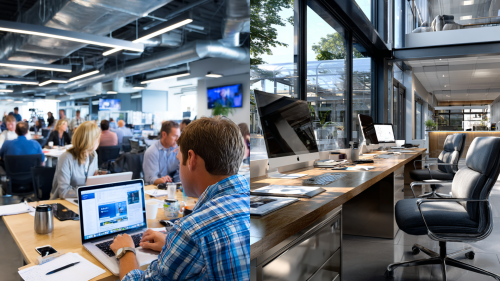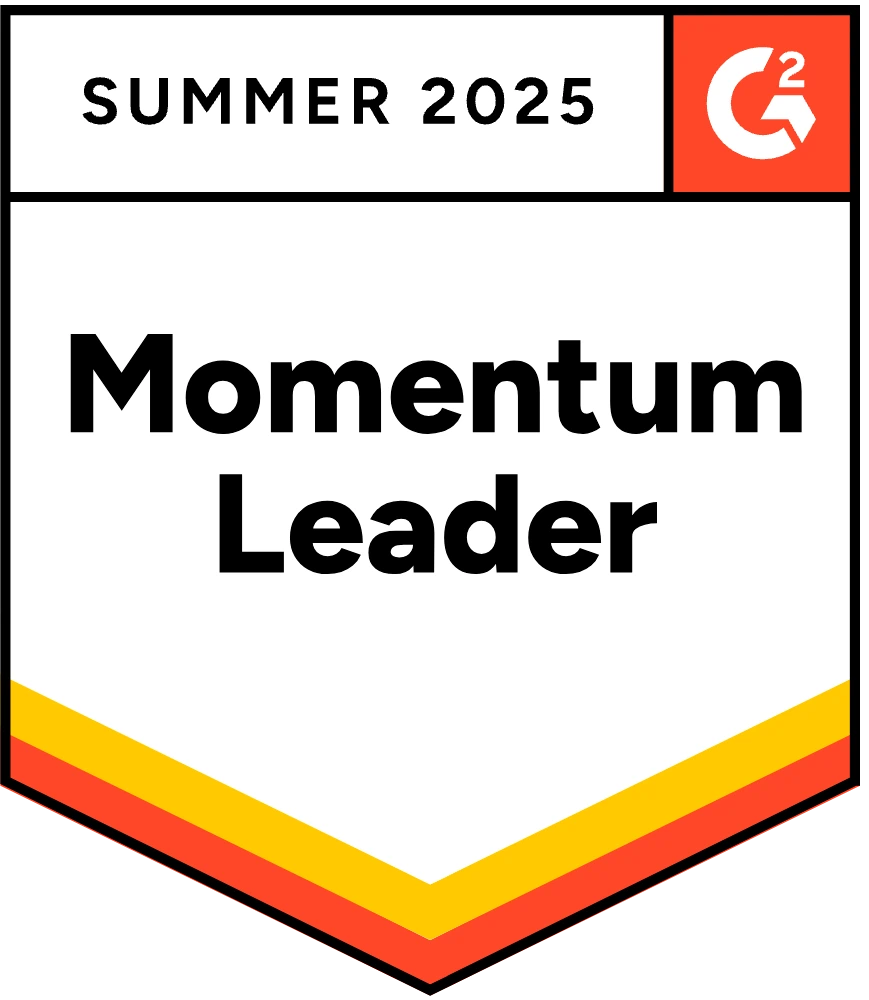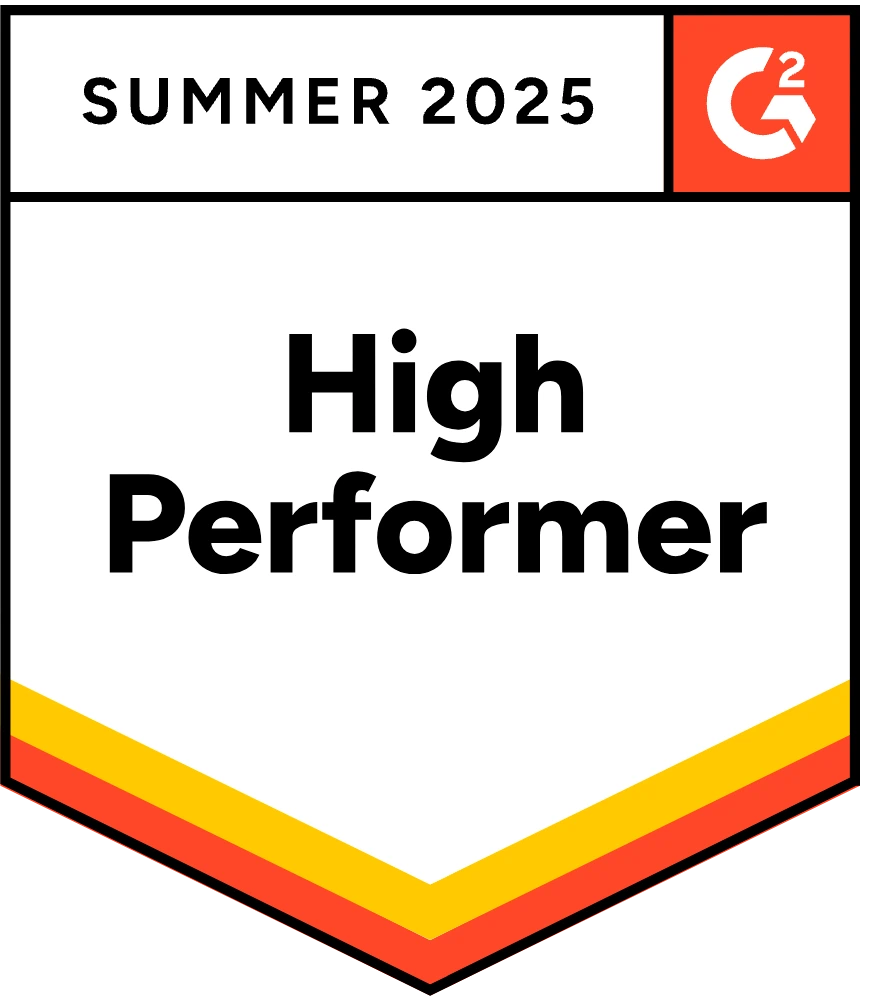Key points
- The hybrid workplace offers employees greater flexibility but it also brings new challenges for real estate teams
- Hybrid workplace solutions (technology, data, and analytics) enable businesses to adapt their spaces to the hybrid world of work
- Key objectives include optimizing space performance (footprint and configuration) and enhancing the employee experience
The hybrid workplace: a new challenge for corporate real estate
As a result of the pandemic, many companies are assessing the implications of a “hybrid workplace.” A hybrid workplace refers to an office concept that enables employees to work both in the physical office or remotely. Hybrid working isn’t new, but its popularity has been turbocharged by the pandemic and the subsequent massive WFH experiment. While employees want it, the hybrid work model also creates new challenges for real estate and workplace leaders.
Hybrid workplace solutions (comprising software and technology, data & analytics) can help them implement a successful hybrid workplace. One that works for people as well as profits the business. There’s the obvious challenge of determining how much office space is still needed. Another essential question, however, is what kind of space employees will require so that they can make the most of their in-office experience.
Technology to support hybrid workplaces
In a hybrid office setup, occupancy becomes less predictable. It also tends to vary more widely during the week. Under these circumstances, smart workplace technologies – and the data derived from them – provide much-needed support. To begin with, they help organizations quickly identify and adapt to new work patterns. In addition, they help employees navigate the flexible workplace environment thanks to IoT real-time data. Furthermore, they inform hybrid workplace (re)design strategies, enabling companies to create workspaces that support people’s well-being as well as their productivity. In short, smart workplace technologies and analytics support businesses to effectively shift from pandemic workplace disruption to post-pandemic flexibility and resilience.
In a hybrid office setup, occupancy becomes less predictable and varies more widely during the week.
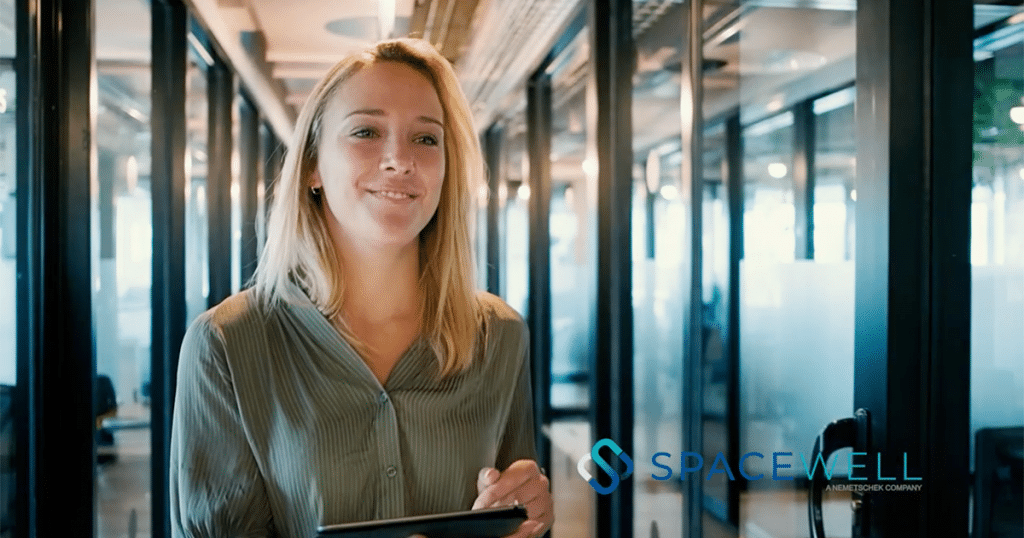
Managing space in a hybrid office
One of the conclusions many companies have drawn from the pandemic is that focused work can, for many employees, be done just as well – if not better – from home as in the office. Many types of collaboration and socialization, on the other hand, are better suited to face-to-face interactions. Particularly when they involve new employees. As a result, many companies expect to dramatically increase the availability of conference rooms, huddle areas, and other collaboration or flexible spaces to accommodate new ways of working.
But even if the office becomes a collaboration hub, there is still considerable uncertainty around how much of each type of space will be needed. How intensely this space will be used. And how much employees’ need for space has been changed by social distancing.
The best way to answer those questions isn’t to theorize about the future of the office but to put in place the technology that allows space managers to
- Monitor precisely how their space is actually being used
- Optimize their space continually to adjust to the way office use is changing.

Employee experience in a hybrid workplace
Beyond optimizing the configuration and amount of space, another concern for many workplace managers is how to create an employee-centric environment.
One approach taken by many companies has been to deploy workplace apps that allow building users to make reservations, find colleagues, book services, request cleaning and maintenance, and visualize indoor air quality metrics for their space. By sharing information and streamlining processes, these apps make the workplace experience more pleasant and productive. They can also give employees a greater sense of control as they transition back to the office.
Beyond optimizing the configuration and amount of space, another concern for many workplace managers is how to create an employee-centric environment.
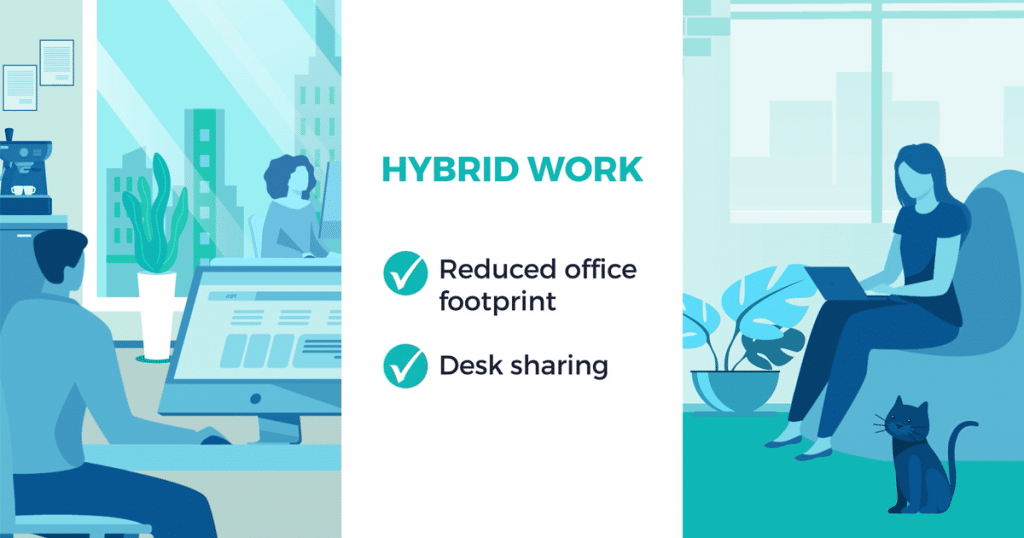
Why invest in hybrid workplace solutions now?
Investing in technology for the physical office at a time when we are seeing fewer people in the workplace may seem counterintuitive. Why spend money monitoring a space that only half of your employees will use? But for space managers who want to know just how much of their lease they can give up or repurpose and how best to reconfigure their space, data will be essential. While it may be tempting to follow the trends of what a “typical” post-pandemic office might look like, we believe that basing decisions on your own utilization data will be key to success.
Basing workplace decisions on your own utilization data will be key to success.
What can an organization expect to achieve by implementing a hybrid workplace solution?
5 key objectives for hybrid workplace solutions
1. Enabling workplace flexibility
One of the leading predictions for the hybrid workplace is that this new model will embrace flexibility in all its forms – including around seating. When only a portion of your employees comes to the office on any given day, assigned seating quickly reveals itself to be a highly inefficient practice. The anticipated growth of unassigned or flexible seating to reflect new ways of working will mark a significant shift. Whereas assigned seating was employed in the majority of U.S. workplaces prior to the pandemic, surveys – such as CBRE’s 2020 Global Occupier Sentiment Survey – suggest that flexible seating is likely to become the new norm
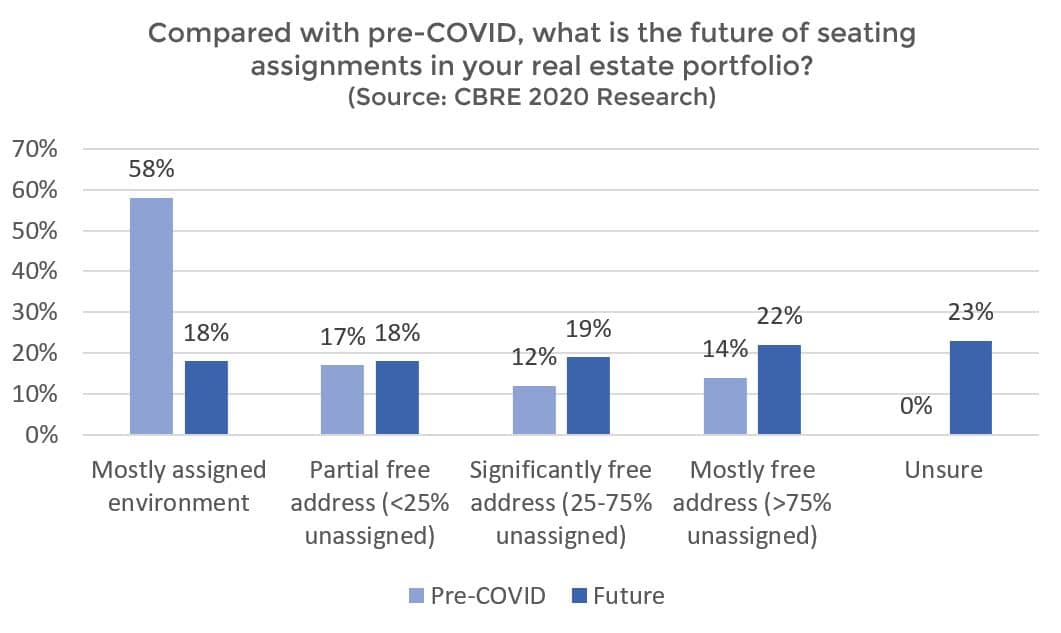
The challenge of flexibility
Flexible seating, of course, can mean many different things. In some cases, it may involve reserving a seat for an extended period (such as the whole day) one or more days in advance. In other cases employees might change seats multiple times during a day using an ad hoc check-in/check-out system. But whether flexibility means hoteling, hot-desking, or something in between, it requires a robust reservation system to function smoothly.
What’s different about hybrid flexibility?
Everyday frictions around flexible seating already existed well before the pandemic. However, the hybrid office adds an additional layer of complexity to the flexible workplace.
First, in a hybrid work environment, the benefits of flexible seating arrangements increase dramatically. Each day (or part of a day) at which an employee is working from home represents a vacant workstation when seating is assigned. In high-rent areas, the cost of vacant seats can be substantial. Workplace managers can avoid this cost by making the space available to someone else, eliminating it, or repurposing it for collaboration.
Second, there is a need to account for and engage employees who are not at the office. This increases the importance of reservations as a tool for connecting people. Workplace apps can use reservations data as a basis of a people finder feature, which makes it easy to find out who is in the office and where they are sitting. All without tracking employee movements.
Finally, there are likely to remain some employee sensitivities around safety at the office for some time. Workplace leaders can measure and share information about crowdedness in the office using live sensor data. This can be a valuable complement to reservations systems. Because it helps employees choose spaces in areas that are more or less crowded depending on their comfort level.
2. Optimizing office footprint
Most companies expect to see changes to ways of working that could significantly shape office space needs. But many of the trends are pulling in opposing directions. Moreover, it is unclear how persistent those trends will be. Just as many reports emerged about “Zoom fatigue,” the appeal of hybrid or remote work may also wane over time.
Various types of sensors can track occupancy and utilization of spaces.
Under these circumstances, the best way to plan for and adapt to workplace changes is to collect and analyze high-quality data about how the office is actually being used. Various types of sensors can track true occupancy and utilization of spaces, revealing patterns such as:
- Which collaboration spaces are most popular and which are empty
- Whether workstations are truly a thing of the past; or whether employees treat the office as a place to get away from distractions from home
- If the choice of working from home or the office is affected by seasons, with some choosing to shift entirely to the office to have access to better air conditioning or heating
- Whether or not hybrid work trends are the same across all locations.
Here it is crucial to note that sensors themselves are only a partial solution. The ability to make informed portfolio decisions ultimately depends on the quality of the analytical tools. And on the ease of translating raw data into useful insights. In other words, choosing the right analytics platform is just as important as choosing the right sensor.

3. Optimizing office space configuration
Hybrid working might not only impact the size of the office footprint, but also the kind of spaces people will seek out when they return to the office. There is a growing chorus of analysts projecting a shift towards collaboration and socialization spaces in the office, with some companies already in the process of redesigning their offices to accommodate this change.
There are good reasons to embrace collaboration and to expect an increase in demand for group spaces. But there are also valid reasons to take a more cautious approach. Before transforming the entire real estate portfolio, companies might benefit from closely monitoring actual usage information to see where employees are gravitating in the reopened office.
Crafting an office configuration strategy
Rather than redesigning offices to respond to forecasts about dramatic changes to the office, another approach to office configuration is to focus on data trends. Some immediate office reconfigurations certainly make sense. But companies may also benefit from a more gradual approach in which they monitor both occupancy and utilization of different types of spaces available in the office. That way, they can align supply and demand for space over time.
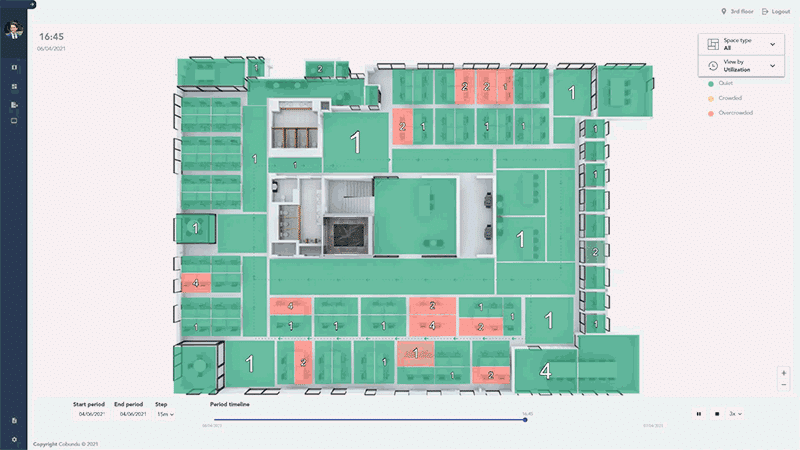
The objective of such a strategy would be to identify spaces that are over- or underperforming on either occupancy (whether or not spaces are being used), utilization (how close to capacity they are being used), or both. In this way, managers can identify which spaces are being under- or over-provided. And make adjustments over time to optimize the way space is being used. This deliberative approach:
- Provides greater transparency about decision-making
- Ensures that companies are not rushing into significant investments that might not reflect their workforce
- Allows for tailored space strategies to develop across different locations, reflecting the specific needs of those offices.
Read how AXA created a dynamic workplace concept with a range of shared spaces and a 0.6 desk-to-employee ratio (1540 workstations for 2600 staff members)
Read4. Ensuring Good Indoor Air Quality
Air quality is invisible, which is why building managers have tended to ignore it, focusing more on a comfortable temperature or on saving energy. The pandemic, however, has heightened people’s awareness of the indoor environment and brought a new focus on air quality.
Employees want to be confident that the air in their workspaces is clean when they return to the office. And employers are realizing that good indoor air quality is a business advantage. Because poorly circulated air in buildings not only affects health and wellbeing – while also increasing the risk of airborne pathogens such as the coronavirus — it also impairs our cognitive function: the ability to think clearly and creatively. So how do we know if the indoor air is clean?
IoT monitoring
These days small sensors in the workplace can monitor many aspects of environmental quality. From the presence of volatile organic compounds (VOCs) and radioactive radon gas to CO2 concentrations, temperature, humidity, air pressure, particle matter, noise, and light. The measurements are ingested by an IoT platform that transforms them into accurate data. It then analyzes and visualizes the data on floor plans and dashboards, providing insights to improve indoor air quality.

5. Supporting hybrid office dynamism
How does hybrid office dynamism present a real estate challenge?
The challenge of flexible working on a large scale is simply this: If employees’ independent choices tend to be clustered on the same times and days, the result is likely to be highly inefficient from a real estate perspective.
One solution that has been proposed is to schedule shifts or rotations at the office. Specific teams or departments would be assigned to certain days and office traffic will be largely predictable (with some room for error to accommodate drop-ins). This solution would likely be effective for space planning, with software scheduling and reservation tools used for easy assignment or reassignment. It would, however, also diminish employee choice and flexibility and reduce chance encounters between employees assigned to different rotations. In organizations with fluid teams, it could also result in unpredictable schedules, undermining some of the personal benefits of flexibility.
Addressing the challenge through monitoring
However, it may not actually be necessary for every organization to set such strict policies to make hybrid working effective. The preceding scenario is simply one hypothetical and employees might naturally fall into different patterns. Parents, for example, might choose to build their office schedules around children’s pick-up and drop-off times, coming in to work part of the day every day. Other employees might set their office schedule according to the choices of their team or manager or might follow different schedules depending on the stage of their project. Young or new employees might choose to go to the office more often in search of mentoring and networking opportunities. Aggregated across an entire office, peaks, and troughs in utilization might be far less extreme than in the previous hypothetical – or they might vary wildly across different offices.
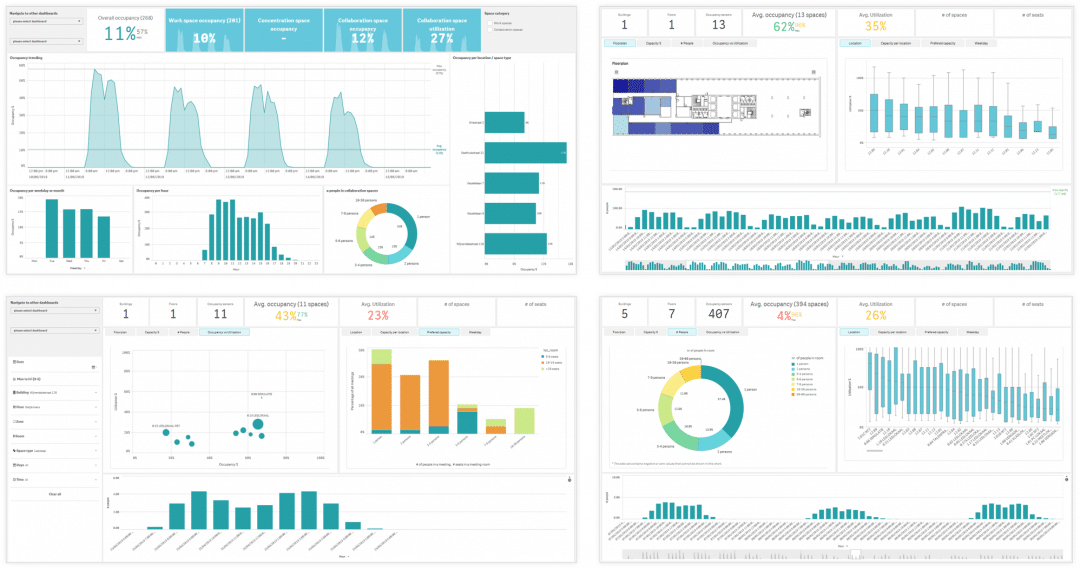
Organizations that do not have to make their real estate choices immediately (perhaps because their leases still have several years on them) have the luxury of being able to assess how hybrid working dynamics are actually going to unfold. Sensors are a powerful tool for capturing historical trends surrounding peaks, troughs, averages, and flows of traffic across different locations and spaces. When their data is aggregated and run through analytics programs, real estate teams can use the findings to assess what the hybrid working patterns are and verify whether they are truly stable or change once the initial novelty of hybrid working wears off.
Data-informed decision making
Those patterns can then be used to make data-driven real estate decisions. These will ensure that there is sufficient space to accommodate peak traffic without too much waste. And they will enable businesses to redesign office layouts or change seating patterns to accommodate flexible working. Other teams can use the data to make better decisions around service provisions and, if necessary, also introduce or redesign remote working policies based on transparent information.
Looking to create an effective, people-centric hybrid workplace? Contact us to see how our hybrid workplace solutions could benefit you.


